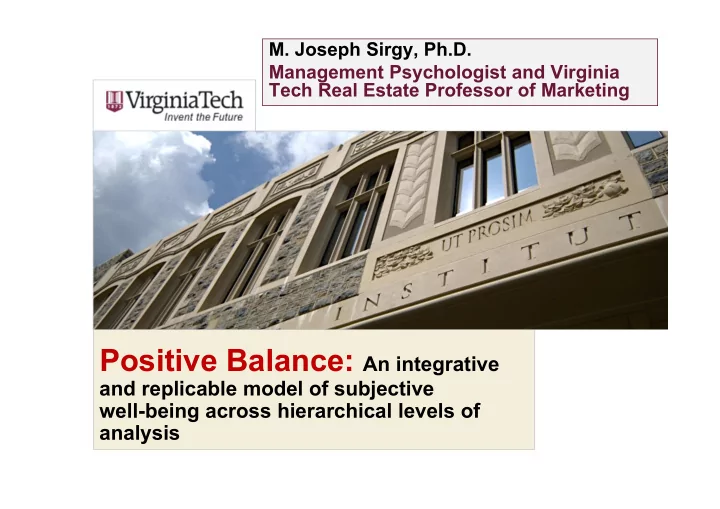

M. Joseph Sirgy, Ph.D. Management Psychologist and Virginia Tech Real Estate Professor of Marketing Positive Balance: An integrative and replicable model of subjective well-being across hierarchical levels of analysis
This presentation is based This presentation is based partly on: partly on: Sirgy, M. J. (2019). Positive Sirgy, M. J. (2019). Positive balance: A hierarchical balance: A hierarchical perspective of positive perspective of positive mental health. Quality of Life mental health. Quality of Life Research , 28 , 1921-1930. Research , 28 , 1921-1930. 2
Positive Mental Health, Positive Balance, Positive Mental Health, Positive Balance, Subjective Well-Being, Hierarchy Subjective Well-Being, Hierarchy Positive mental health Positive balance Subjective well-being Hierarchy 3
Positive Mental Health Positive Mental Health Positive mental health (mental well-being) Negative mental health (mental ill-being) 4
Positive Balance Positive Balance Balance versus imbalance Positive balance = preponderance of a positive psychological state over a negative state 5
Subjective Well-Being Subjective Well-Being 1. Positive and negative neurotransmitters 2. Hedonic well-being 3. Domain satisfaction 4. Life satisfaction 5. Eudaimonia 6. Social well-being 6
A Hierarchical Perspective A Hierarchical Perspective Socio-ecological Developmental Meta-cognitive Cognitive Emotional Physio- logical 7
POSITIVE BALANCE AS POSITIVE MENTAL SUPPORTIVE THEORETICAL LEVEL OF ANALYSIS HEALTH NOTIONS EMERGENCE Positive mental health Individuals experiencing a preponderance of Stress response system); Preponderance of neurochemicals associated with defined at a neurochemicals related to positive emotions neurobiology of happiness) positive affect (dopamine, serotonin, and oxytocin) physiological level = (dopamine, serotonin, oxytocin) relative to relative to neurochemicals associated with negative positive and negative neurochemicals related to negative emotions affect (cortisol) contribute significantly to hedonic neurotransmitters (cortisol) well-being. Positive mental health Individuals experiencing a preponderance of Positive versus negative affect; Preponderance of positive affect (happiness, joy, defined at an positive emotions (happiness, joy, serenity, broaden and build theory; flow) serenity, contentment, etc.) relative to negative emotional level = contentment, etc.) relative to negative emotions affect (anger, sadness, jealousy, envy, depression, hedonic well-being (anger, sadness, jealousy, envy, depression, etc.) etc.) contribute significantly to domain satisfaction. Positive mental health Individuals experiencing a having a Principle of satisfaction limits; Preponderance of domain satisfaction (satisfaction defined at a cognitive preponderance of domain satisfaction (satisfaction principle of the full spectrum of in salient and multiple life domains such as family level = domain in salient and multiple life domains such as family human developmental needs; life, work life, social life, etc.) relative to satisfaction life, work life, social life, etc.) relative to principle of diminishing dissatisfaction in other life domains contribute dissatisfaction in other life domains satisfaction significantly to life satisfaction. Positive mental health Individuals experiencing a preponderance of Multiple discrepancies theory; Preponderance of positive evaluations about one’s congruity life satisfaction; life using certain standards of comparison defined at a meta- positive evaluations about one’s life using certain cognitive level = life standards of comparison (satisfaction with one’s personal strivings; basis of life (satisfaction with one’s life compared to one’s past satisfaction life compared to one’s past life, the life of family satisfaction judgments; social life, the life of family members, the life of members, the life of associates at work, the life of comparisons in life satisfaction; associates at work, the life of others in the same others in the same social circles, etc.) relative to frequency of life satisfaction social circles, etc.) relative to negative evaluations negative evaluations about one’s life using similar judgments) about one’s life using similar or other standards of comparison contribute significantly to eudaimonia. or other standards of comparison Positive mental health Individuals experiencing a preponderance of Virtue ethics and balance; self- Preponderance of positive psychological traits defined at a positive psychological traits (self-acceptance, determination theory; hedonic (self-acceptance, personal growth, purpose in life, developmental level = personal growth, purpose in life, environmental versus eudaimonic happiness; environmental mastery, autonomy, positive eudaimonia mastery, autonomy, positive relations with others, personal expressiveness; relations with others, etc.) relative to negative etc.) relative to negative psychological traits psychological well-being psychological traits (pessimism, hopelessness, (pessimism, hopelessness, depressive disorder, depressive disorder, neuroticism, impulsiveness, neuroticism, impulsiveness, etc.) etc.) contribute significantly to social well-being. Positive mental health Individuals experiencing a preponderance of Social well-being, need to defined at a social- social resources (social acceptance, social belong, attachment theory; social ecological level = actualization, social contribution, social exclusion and ostracism, social 8 social well-being integration, etc.) relative to social constraints harmony (social exclusion, ostracism, etc.)
Recommend
More recommend